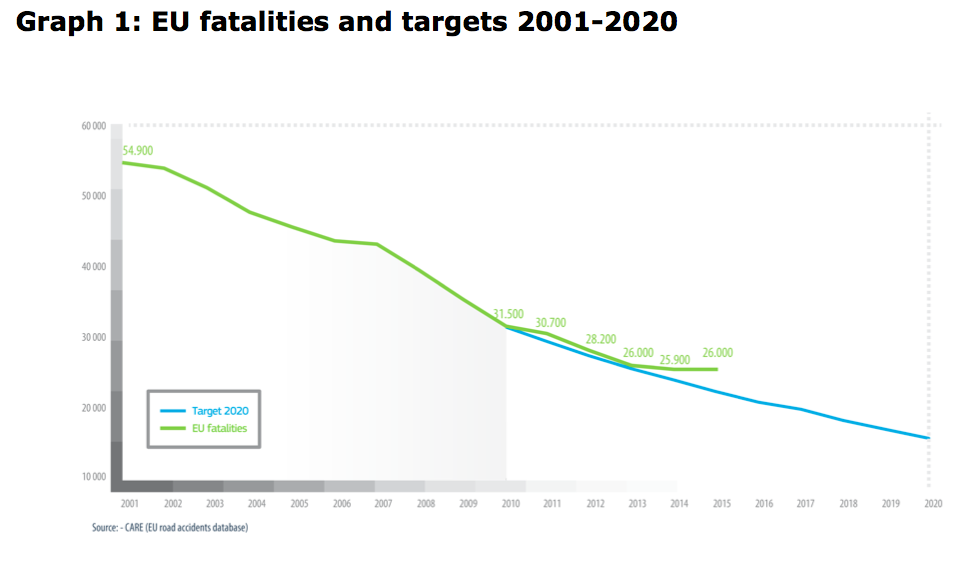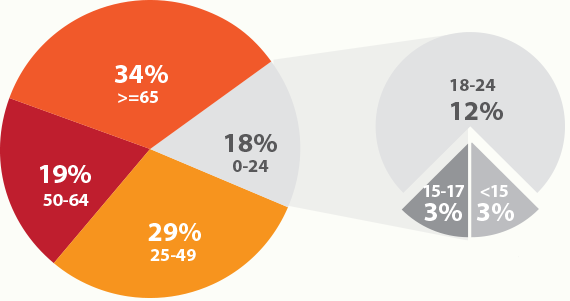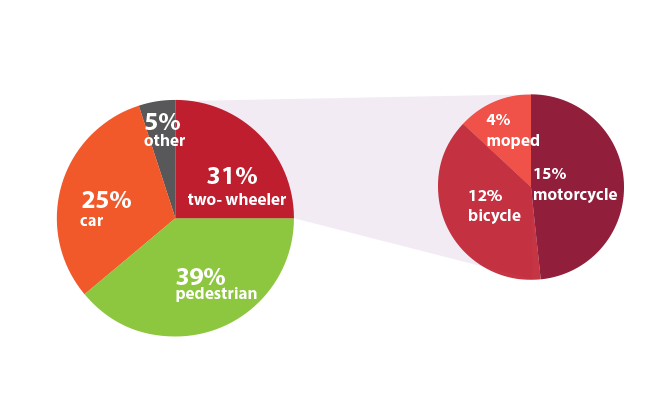
3 Apr, 2016
Road Safety: 26,000 killed in Europe traffic accidents in 2015, social cost €100 billion
Brussels, 31 March 2016, European Commission Press release – The 2015 road safety statistics published today by the European Commission confirm that European roads remain the safest in the world despite a recent slowdown in reducing road fatalities.
The 2015 road safety statistics published today by the European Commission confirm that European roads remain the safest in the world despite a recent slowdown in reducing road fatalities. 26,000 people lost their lives on EU roads last year, 5,500 fewer than in 2010. There is however no improvement at EU level compared to 2014. In addition, the Commission estimates that 135,000 people were seriously injured on EU roads. The social cost (rehabilitation, healthcare, material damages, etc.) of road fatalities and injuries is estimated to be of at least €100 billion.
EU Commissioner for Transport Violeta Bulc said, “Every death or serious injury is one too many. We have achieved impressive results in reducing road fatalities over the last decades but the current stagnation is alarming. If Europe is to reach its objective of halving road fatalities by 2020, much more needs to be done. I invite Member States to step up efforts in terms of enforcement and campaigning. This may have a cost, but it is nothing compared to the €100 billion social cost of road fatalities and injuries. For its part, the Commission will continue to act where it can bring a clear European added-value. Technology and innovation are increasingly shaping the future of road safety. In the medium to long term, connected and automated driving, for instance, has great potential in helping to avoid crashes, and we are working hard to put the right framework in place.”
The average EU fatality rate for 2015 was 51.5 road deaths per 1 million inhabitants, similar to the past two years. This slowdown, which follows a significant reduction of 8% in 2012 and 2013, has several contributing factors, such as a higher interaction between unprotected and motorised road users in our cities. Vulnerable road users (pedestrians, cyclists, etc.) also account for a large proportion of the 135 000 people the Commission estimates[1] were injured. This is the first time the Commission publishes such a figure, as EU Member States have started to report comparable and reliable data on serious road traffic injuries. This is the first step towards a European approach to serious injuries.
The country-specific statistics (see below) reveal that the number of road fatalities still varies greatly across the EU, though this gap is becoming smaller every year. Some traditionally well-performing countries recorded less progress while three of the Member States with the highest number of road deaths improved their road safety situation.
Improving EU road safety
In order to reach the EU strategic target of halving the number of road deaths from 2010 to 2020, additional efforts are needed. Member States are the main actors as most of the day-to-day actions are delivered at national and local level: enforcement of traffic rules, infrastructure development and maintenance but also education and awareness raising campaigns. The European Commission acts where there is a clear EU added-value, for instance through legislation enabling the enforcement of cross-border traffic offences or by setting technical safety standards for infrastructure and vehicles. The Commission actively monitors the situation, stimulates and helps Member States to improve their performance through the exchange of data, knowledge and experience, and by sharing best practices.
Technological breakthroughs in the last decade have greatly improved vehicle safety. The significant advances in innovation and technology have a strong future potential to improve road safety, in particular in the area of vehicle automation and connectivity. To pave the way towards automation and better management of traffic, the Commission aims to develop a master plan on the deployment of cooperative Intelligent Transport Systems (ITS) – a two-way communication between vehicles, with and between road infrastructure – in the second half of 2016. Such systems allow vehicles to warn each other directly (e.g. in case of emergency breaking) or through the infrastructure (e.g. upcoming road works).
2015 road safety statistics: What is behind the figures?
Over the last decades, the EU has made great progress in reducing road fatalities. Between 2001 and 2010, Europe cut the number of road deaths by 43% in spite of the increased traffic volumes, and reduced it by another 17% since 2010.
Furthermore, with 51.5 road fatalities per one million inhabitants, Europe has the lowest fatality rate for any region in the world. This ratio amounts to 106 in the United States and to 174 globally[1].
However, the progress rate has lately clearly slowed down: change in fatality figures was close to 0 from 2013 to 2014, and 2015 repeated the same pattern. The current slowdown means that efforts must be stepped up, especially at national level, if the strategic target of halving the number of road deaths by 2020 is to be reached.
Graph 1: EU fatalities and targets 2001-2020

How can this recent slowdown be explained?
The slowdown marking the last three years certainly has several contributing factors. Some of them are evident, based on statistics[2]: a higher interaction between unprotected and motorised road users in our cities, and an ever growing number of elderly people in road traffic. Some other causes commonly referred to are urbanisation with a growing number of vulnerable road users; an increase of traffic during milder winters in Europe; less resources dedicated to road maintenance and vehicles following the economic crises; and last but not least the appearance of new trends in users’ behaviour, such as distraction mainly by mobile phones.
What does the new data on serious injuries show?
For every person killed in traffic crashes, many more suffer serious injuries with life-changing consequences. The serious injuries are not only more common but also often more costly to the society because of long-time rehabilitation and healthcare needs. Vulnerable road users, such us pedestrians, cyclists, motorcyclists or elderly road users are especially affected.
As from 2015, Member States started to report for the first time data on serious injuries based on a new, commonly agreed definition following medical standards[3]. According to estimates, 135 000 people were seriously injured on Europe’ roads[4]. The majority of those seriously injured were vulnerable road users, pedestrians, cyclists and drivers of powered two-wheelers. Their proportion was even higher in towns and cities.
Building on this progress in data collection, the Commission will be able to monitor and benchmark Member State performance and assess how to further stimulate it. Also, the new data shows that fatal crashes and crashes resulting in serious injury have slightly different characteristics. This will help to see where more work is needed, such as on safety for vulnerable road users or safety in urban areas.
How did the different Member States perform in reducing the number of fatalities?
While all the EU Member States have improved their road safety records since 2010, there is still a significant gap in their performance. In 2015, countries with the lowest fatality rate per million inhabitants were Sweden (27), the Netherlands (28), the UK (29), Denmark (30) and Malta (26). On the other hand, those with the weakest road safety records were Romania (95), Bulgaria (95), Latvia (94), Lithuania (82), and Croatia (82), even if two of them marked a significant decrease from 2014 to 2015, namely Latvia (-11%) and Lithuania (-10%).
In 2015, for the first time ever, seven EU countries recorded a fatality rate below 40 deaths per million inhabitants (EU average was 51.5). In addition, and for the very first time, none of the Member States had a fatality rate above 100 deaths per million inhabitants.
Graph 2: Fatalities per million inhabitants by country – 2014 and 2015

Which types of roads and which users are most affected?
- On average, only about 7% of the fatalities are caused on motorways. 38% of all road deaths happen inside urban areas. However, the majority of fatalities (55%) occur in rural areas.
Graph 3: Road accidents and road fatalities by type of roads

- Vulnerable road users, including pedestrians, cyclists and motorcyclists account for almost half of the road victims, and their proportion is even higher in urban areas.
Graph 4: Road fatalities by age in urban areas

Graph 5: Road fatalities by transport mode in urban areas

- 22% of all people killed on the roads are pedestrians, and pedestrian fatalities decreased slower than other fatalities (by 11% from 2010 to 2014, compared to the total fatality decrease of 18%). The share of pedestrian deaths is especially high in Romania, Latvia, Estonia, Poland and Lithuania where more than a third of all killed in road traffic crashes are pedestrians.
- Cyclists make up 8% of all who died on the road in the EU. The number of cyclist fatalities decreased by only 4% between 2010 and 2014, which is much lower than the total fatality decrease (18%). There were significant differences between Member States. The share of cyclist deaths is especially high in the Netherlands (25%), as well as in Denmark and Hungary (16%). The differences of course mirror the popularity of cycling in different Member States but also e.g. the safety of bike paths, the safety awareness of cyclists themselves (e.g. helmet use) and the awareness among drivers of the safety of surrounding cyclists.
- Motorcyclists make up 15% of road fatalities. This reflects the fact that riders are less protected in case of a crash. There are big differences between Member States. The share of motorcyclist deaths is especially high in Greece (31%), Italy (21%), France (19%), Austria (18%), Spain (17%) and Germany (17%).
- Men are overrepresented among road victims: 76% of all who die in road traffic crashes. The young still face the largest risk in traffic: those between 15 and 24 years make up 11% of the population but 16% of all road fatalities. However, in the last years fatalities among young road drivers have decreased by 32% between 2010 and 2014, more than for any other age group. In parallel, the share of road deaths of elderly people (9%) has decreased only by 3%.
What is the EU doing for safer roads?
Member States are the main actors in reducing fatalities as the biggest part of road safety policies fall under the principle of subsidiarity. To reach the strategic target of halving the number of road deaths by 2020, Member States need to step up actions, addressing infrastructure and vehicles safety, and in particular focusing on awareness-raising and education, as well as efficient enforcement of traffic rules.
The EU has created a general framework for improved road safety with legislation and recommendations, for example by having introduced minimum requirements for the safety management of the Trans-European Transport Networks and technical requirements for safe transport of dangerous goods. Most recent initiatives include the cross-border enforcement directive, entered into application on 6 May 2015, to tackle driving offences committed abroad, and new legislation on roadworthiness testing, adopted in April 2014, to decrease the number of traffic accidents caused by technical failures.
In 2015 another milestone for road safety was reached with the agreement on the deployment of innovative technology that can save lives. As of March 2018, all new vehicle types will have to be fitted with the eCall system. eCall automatically dials Europe’s single emergency number 112 in the event of a serious road accident and communicates the vehicle’s location to the emergency services. eCall cuts emergency services response time by up to 50% in the countryside and 40% in urban areas. It is estimated that eCall can reduce the number of fatalities by at least 4% and the number of severe injuries by 6%.
Ongoing and upcoming initiatives include:
- Review and monitoring of existing legislation:
– A review of the infrastructure safety directive is under way to investigate possible wider benefits of the directive, e.g. additional protection for vulnerable road users, technical requirements to facilitate the deployment of ITS solutions or the setting of minimum safety performance requirements.
– Training requirements for professional drivers are also under review to reduce inconsistencies between the professional drivers directive and the EU legislation on driver licences, to improve the safety requirements and to make the directive clearer and easier to interpret. An impact assessment is carried out currently.
– Existing legislation is regularly monitored by appropriate follow-up measures, such as transposition checks, evaluations, implementation reports and in dialogue with Member States primarily within the framework of expert groups and committees.
- Road safety is mainstreamed in the discussions on innovative technologies which have a huge road safety potential.
– To pave the way towards cooperative intelligent transport systems and better management of traffic, the Commission aims to develop a master plan on the deployment of cooperative ITS – a two-way communication between vehicles and the infrastructure – in the second half of 2016. Such systems allow vehicles to warn each other directly (e.g. in case of emergency breaking) or through the infrastructure (e.g. upcoming road works).
– This is also linked to the on-going work on automated driving, e.g. within the Commission initiative GEAR 2030 which also has a strong road safety aspect.
- Studies and projects dedicated to further improving the knowledge on serious road injuries:
– A study launched in October 2015 analyses crashes causing serious injury in order to identify a number of the most common crash scenarios with serious injuries as an outcome. Results should be available by November 2016.
– The SafetyCube research project funded under Horizon 2020 aims to support the selection and implementation of strategies and measures to reduce casualties in Europe and worldwide. The project includes a comprehensive analysis of accident risks, and it will provide guidelines for the registration and monitoring of serious road injuries.
The Commission stimulates and supports Member States in their activities to improve road safety through different knowledge sharing platforms and activities, such as the High Level Group on Road Safety, country visits, peer-reviews or the European road safety days. These occasions bring together policy-makers, experts, NGOs and the industry. The Commission has furthermore created and runs the European Road Safety Charter, a large platform, with more than 2800 members today, that mobilises public and private entities as well as the civil society in all the 28 EU countries for voluntary commitments to road safety actions.



Liked this article? Share it!